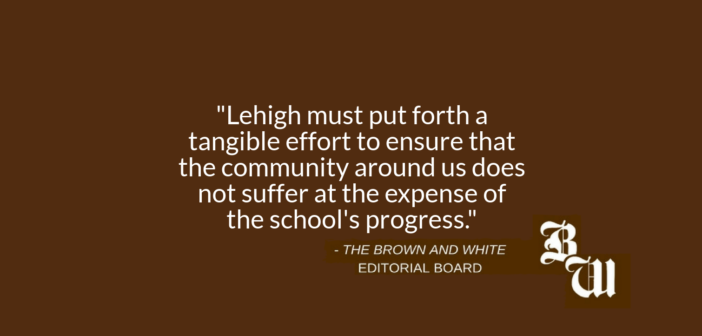A Department of Labor report from February 2019 stated that unemployment rates in both Pennsylvania and the United States are universally on the decline. Simultaneously, the unemployment rate in the Bethlehem community has remained both stagnant and high.
As South Bethlehem faces rapid and rampant gentrification, it is justifiable to question why the unemployment statistics have not improved despite the wide array of restaurants and businesses that have come into the local landscape over the past few years.
Lehigh has made it clear that it prioritizes its relationship with the South Bethlehem community.
In order to mutually thrive in a seemingly unavoidable gentrification, both the university and the community at large must work to ensure symbiotic success. If Lehigh continues on a self-serving path of student improvement, they risk increasing the already extreme disconnect with the surrounding community members.
South Bethlehem, which is a verified food desert, has continuously struggled with a lack of affordable, healthy food options. The lack of a “college town” atmosphere serves as a detriment to current students and deters potential students who are looking for a college community to immerse themselves in.
As Lehigh grows, it is in the best interest of the university and its future students to improve the options that exist locally. Amid this change, Lehigh possesses a responsibility not to alter the landscape of the community to a point in which its current residents cannot comfortably sustain the lifestyle that they have grown accustomed to.
If Lehigh’s intentions are true in creating a positive and sustainable relationship with the South Side, then it must put forth a tangible effort to ensure that the community around us does not suffer at the expense of the school’s progress.
Lehigh objectively benefits significantly more from gentrifying than South Side residents do. This is evident through the physical location of the community “improvements” being made. While the few streets surrounding Lehigh have seen chains such as Starbucks, Playa Bowls and El Jefe Taqueria, in the past year alone, if one were to travel just two streets farther, one would see that these improvements come to a standstill.
While it is sensible to make the most dramatic changes where a concentrated viable market, such as the Lehigh student body, resides, the lack of restaurants and changes that span away from the campus exist to benefit Lehigh and not the Bethlehem community at large.
If Lehigh wants to make a legitimate effort towards unification with the community, then it needs to acknowledge the power that it holds to alter it in its entirety. With that power comes the responsibility to uphold the integrity of the community while also making tangible change in the aspects that are suffering.
As both a private university and corporation, Lehigh holds the responsibility to ensure that the surrounding area improves as a result of its growth. If we continue to solely serve students, then no changes will be made and, the preexisting issues will just continue to bolster out of sight.
Unemployment rates signify many things about the strength of a city, and they represent many of the troubles as well, such as socioeconomic status, mental and physical health and more. The dramatic increases of local restaurants and businesses create a multitude of employment opportunities for the widely unemployed community, therefore providing opportunities for the city as a whole to improve.
The employment rate serves as just one of the many tangible opportunities for growth that exists. Through increased university transparency, improved community communication and acknowledging the social responsibility we hold to our neighbors, Lehigh and South Bethlehem possess the opportunity for massive symbiotic improvement that can allow for unified growth, as opposed to divisive struggling.






Comment policy
Comments posted to The Brown and White website are reviewed by a moderator before being approved. Incendiary speech or harassing language, including comments targeted at individuals, may be deemed unacceptable and not published. Spam and other soliciting will also be declined.
The Brown and White also reserves the right to not publish entirely anonymous comments.
3 Comments
Has it occurred to you that antidemocratic regimes normally lie about their employment and other economic stats? And that this president is already known to lie wildly about the value of his own assets, and to direct other people to lie for him? The supposedly wonderful economy doesn’t seem to be doing so wonderfully around here, either, and this is a pretty nice place.
In the meantime, the people who most affect the residents’ quality of life is *you*, primarily by driving up local rents and house prices and squeeze affordable housing out. Could you control this, yes. Local landlords don’t charge above what the market will bear, so make a coalition and say look, we’re not going to price out the others, either you reserve a substantial number of units for mixed low-income or we won’t pay more than whatever you’d get in the non-gentrified areas. At which point the landlords throw a fit, but you’re the market, you can tell them what to do.
You won’t, of course, because you’d have to care more than you do for Sam-the-eagle editorial-writing, and it’d take work and inconvenience you. But as a college-town landlord who depends on students, I can tell you it’d do the trick.
When I visit Lehigh I note many changes. The biggest is probably the loss of Bethlehem Steel. How could you have replaced that. I assume the a relatively large portion of South Bethlehem (SB) wanted to send their children to college and move to the north side to avoid the unique atmosphere of SB. That mission was accomplished and the air was cleaned up as well. Unfortunately jobs as well as pollution disappeared. THe expansion of Lehigh has provided jobs but not the quantity to replace the losses. I doubt if a majority of the new hires live in SB. A short ride around the area indicates that a significant number of SB residents are students. Barring a large company needing relatively unskilled labor moving to SB, gentrification may be only realistic way for progress in SB. The responsible action to take is to tie gentrification to positive action towards those displaced by it. Lehigh’s task is not to prevent gentrification but to create a blueprint that will improve the lives of those who end up being dispossessed and possibly create affordable accessible housing for low end workers who will be locally employed ( such as a recent story on ski resort employees who can no longer afford to live near their jobs but must pay extra money to commute from outside the main town area).
With Lehigh tuition being what it is, I wonder how much Lehigh can do directly other than advise or run academic studies in keeping with its educational mission.
In Atlanta the process has been in progress for a long time. It was easy to see the slums disappear and upscale homes, apartments and businesses appear but the fate of the dispossessed was invisible except for the promises of politicians. http://georgiastatesignal.com/gentrification-reshaping-housing-displacing-residents-atlanta/ . SB has used the former Reading rail right of way for beautification and other purposes similar to many other abandoned rail R/W projects. A large project in Atlanta is another example of inequitable gentrification from Beltline – Wikipedia: Controversy
Due to the massive surge in interest in BeltLine adjacent properties and subsequently increased pricing of such properties[25], many property developers have purchased land in previously low-income neighborhoods and transformed them into luxury living. After having promised to create 5,600 units of affordable housing, the Atlanta BeltLine Inc., has only funded 785, as of July 2017, with overall BeltLine construction halfway completed[26], with a 2030 estimated finish. The findings of Dan Immergluck and Tharunya Balan support that – in their seminal 2017 paper, “Sustainable for whom?” they found that for homes within a half-mile of the BeltLine, home values increased between 17.9 and 26.6% between 2011 and 2015.[27] On this subject, the Housing Justice League has a series of suggestions to preserve the homes, in BeltLine-adjacent neighborhoods, in current residents, as such – including 1) reclaiming vacant housing and securing new property for the creation of true affordable housing, 2) preserve current affordable housing, and 3) build new affordable housing.[28]
Can Lehigh be an catalyst for effective change in SB?
If you want to make the world in a different way – go and create something…do something about it. Throwing around race baiting phrases like “gentrification” is exciting but is divorced from the real world which is much more complicated. If you want better jobs in an area then go create them. Use the new opportunity zone incentive or the new markets tax credit program and create grocery stores and jobs hiring locals. It is not easy work. I have done such economic development work around the country and there is always some sjw or professorial second guessers who lob bombs from a distance while sitting comfortably on their do nothing duffs, complaining about some self-imagined issues who then continue to free ride benefitting from the hard work and risks of developers and entrepreneurs.
From the plan and what has been implemented I believe LU is making changes which will improve the University and the learning life of its students in South Bethlehem – which is its mission. and that there are primarily net benefits into the surrounding South Bethlehem community. Other items to achieve are the responsibility of the municipality, the citizens. and philanthropies.
If you want to make the world a better place become a real estate developer or entrepreneur and take risks. If you don’t like things in this world, go out and change them through hard work.